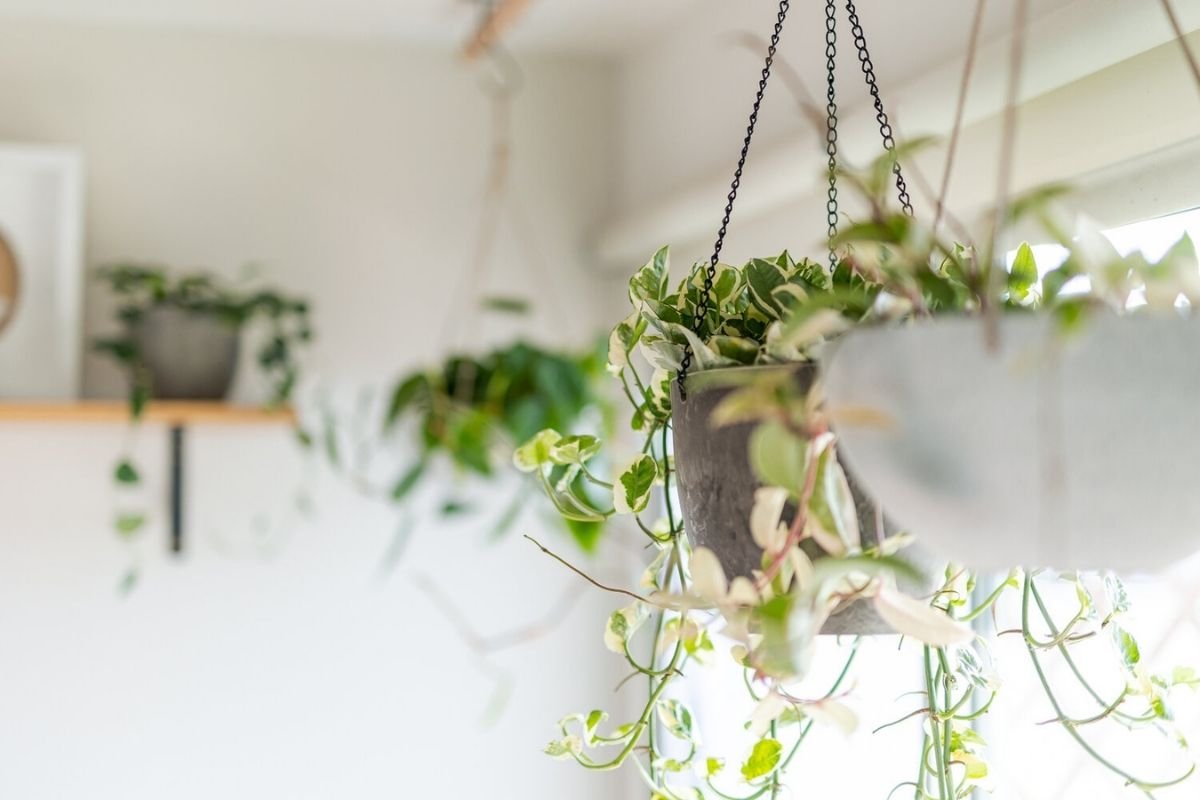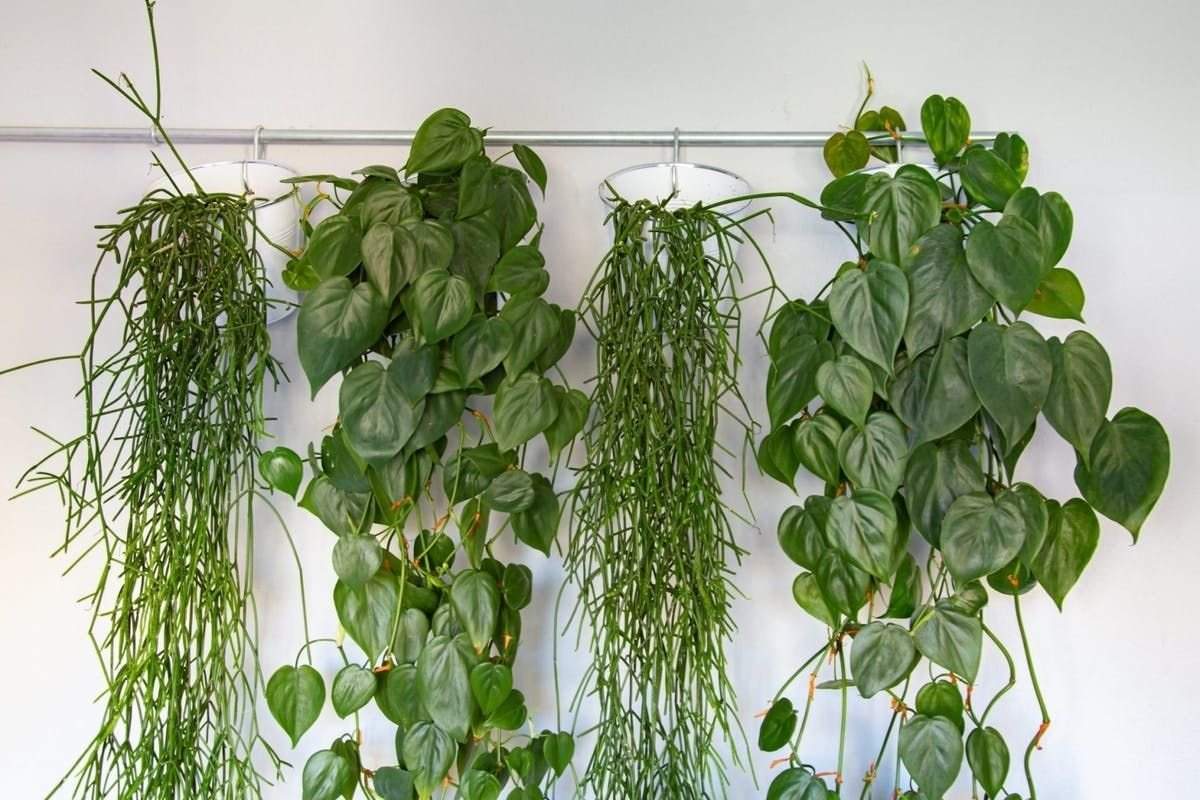What You Need To Know Before You Buy A Hanging Plant
Photo courtesy Mod Musings
Incorporating hanging plants in your home decor has so many benefits: living greenery is the ultimate luscious accessory. It’s also scientifically proven to boost your environment by purifying the air, and to soothe stress! But living plants can also take up space that may be in short supply, and that’s when it’s time for hanging plants to shine! There are a few special characteristics that make some plant varieties perfect options for hanging, and we’ll go into those here, along with everything else you need to know before you buy a hanging plant!
What varieties make perfect hanging plants?
There are a variety of beautiful options to choose from when you’re ready to select a new hanging plant. Our favorites are plant varieties that grow in luxurious tendrils, like Cascading Pothos, Jade Pothos, Philodendron Brasil and Bird’s Nest Fern. Other popular varieties include the String of Pearls, or Curio rowleyanus, and Staghorn Fern.
The Cascading Pothos is a gorgeous option for a stunning hanging plant.
How do you water a hanging plant?
The most convenient way to water your hanging plant will be through a method called bottom watering. Bottom watering is virtually foolproof, because the plant itself decides how much water to soak up, so the risk of overwatering is low- and it also won’t cause water to spill all over your floor, which is a risk if you’re watering your plant in its hanger.
To bottom water your plant, remove the plant from its hanging container, but keep it in its plastic nursery pot, which should have drainage holes in the bottom. Place the plant in a sink, bathtub or tray that has been filled with 1-2 inches of water. Allow your plant to sit in the water for 15 minutes, then take a look at its soil. If it is not yet moist to the touch, give it another 15 minutes. Once it is sufficiently moist, remove the plant from its bath and allow it to sit and drain for ten minutes or so before returning it to its hanging container.
Bottom watering is a great practice to get in the habit of, and it allows the plant to soak up exactly the amount of moisture that it needs. For a helpful tool that will alert you when your plant’s soil is dry and ready for water, consider a moisture meter.
Staghorn Ferns are a natural choice for a gorgeous hanging plant, and have luxuriously velvety leaves.
Hanging plants are great for homes with pets!
If you’re familiar with indoor plants, you probably already know that many of them have varying degrees of toxic compounds in their leaves or stems, which can be dangerous when ingested. It’s a bit inconvenient, we know, but it’s just evolution at work: many indoor plants are tropical varieties that evolved to protect themselves from being eaten by animals. This can make it tricky to choose the perfect plant for your home if you share your space with curious pets or kids. But hanging plants offer an amazing workaround! If you assess your space and hang your plant at a height out of reach of mischief, you can enjoy the beauty of an indoor plant that you might otherwise need to pass on due to its toxicity.
Hanging plants love a good misting
Most plant varieties that make great hanging plants are native to humid environments and appreciate a moist atmosphere. You can boost the humidity level of your hanging plant by misting it regularly (about two to three times a week) with plain water, or a mixture of water and a nutrient-rich foliar feed. Just be sure to follow the instructions on the bottle when diluting the foliar feed into your watering can.
What kind of light will a hanging plant need?
The light requirements of your plant will vary by their species, so it is important to get to know the plant you’re buying before you hang it. Many indoor plants are tropical varieties that cannot withstand strong, direct light, which can scorch their leaves. (Essentially, direct light can cause a plant sunburn.) If you’re planning on hanging your new plant directly in a window, it’s important to be extra careful: the air next to windows can get quite hot from the sun’s reflection, and that combination of strong, direct light and heat is not appropriate for all plants.
Remember that your plant is a plant of its species first, and a hanging plant second. Its care will need to be tailored to its specific requirements.
Who wouldn’t want a sweet tumble of heart-shaped leaves? The foliage of Philodendron Brasils grows into a waterfall effect over time, making this plant a perfect option for a hanging plant.
What kind of container should you use for a hanging plant?
You have more gorgeous options than ever when choosing a container to house your hanging plant. Why? Because hanging plants are in style, and the market knows it! So whether you are seeking a streamlined, modern cylinder hanger or an earthy macrame style, the perfect container is out there just waiting for you. With that in mind, it’s time to consider the less exciting, but still necessary, aspects of practicality. A good container for a hanging plant will not be extremely heavy, unless you have super-strong ceilings and know your way around mounting hardware and tools! It will also provide an even distribution of support for your plant and its plastic nursery pot, and will not obstruct your plant’s natural growth direction.
Tips and tricks for hanging plants
There are plenty of ways to incorporate hanging plants in your home, even if you do not have the tools necessary to hang your container directly from your ceiling. Sun-loving plants can be hung from curtain rods, often to great effect! And if your ceilings or walls cannot support heavy weight, air plants are, well, light as air! They’re a wonderful option for a lightweight hanging plant because they do not require soil, which accounts for most of the weight of hanging plants. If you long for the look of hanging plants but are wary of the process of hanging them, trailing plant varieties like Pothos and many Philodendrons are gorgeous on elevated pedestals, and Staghorn Ferns are beautiful when mounted on wooden planks, then hung on walls just like a piece of art. Staghorn Ferns are also lightweight, because they do not require soil.
Finally, experiment with your foliage! If your hanging plant features tendrils of trailing foliage, they can be secured to grow along walls or to spread out in lush waterfalls. Hanging plants have the potential to be incredibly sculptural, and you can encourage them to grow in specific directions or patterns.
Where to place your hanging plant
If you already have a spot where you know you want to place your hanging plant, it’s simple: you just need to buy a plant variety that will be happy with the light and temperature that space receives. But if you’re on the other side of the equation: you know what plant you’d like to buy, but not where to hang it, there are a few things to consider. Use a light guide to determine the kind of light your space receives overall, and to identify the ideal area in your home for your new plant.
How to select a thriving, gorgeous hanging plant
There are always a few things to check up on as you shop to make sure you pick the perfect plant specimen for your home. Begin by carefully inspecting the plant’s overall foliage. Healthy plants for hanging will have vibrantly colored leaves and foliage, without significant yellowing leaves or discoloration. Additionally, the leaves, stems and trunks of healthy plants will have a firm texture and strong limbs, and will not appear floppy or exhausted.
The definition of #hangingplant goals! Photo courtesy The Spruce.
Avoid purchasing your hanging plant from a garden center
It’s not just advisable: it is essential to buy any living plant from a premium grower. Garden centers and home improvement stores often appear to offer low prices and convenience, but we ultimately find that purchasing plants of a sub-par quality results in a higher cost and less convenient experience overall. There are a few reasons for this.
Garden centers and home improvement stores tend to provide the same kind of care to all of their plants, regardless of the specific needs of the plants’ species. This means that many plants are overwatered during their time at these stores, and are often receiving light that’s inappropriate for their particular requirements.
It is almost impossible to know the plant care routines that these businesses have in place from the outset, but it’s highly common for garden centers to use a one-size-fits-all approach with their plants, and although it saves time for these businesses, treating all plants in the same way is just not conducive to their health.
Purchasing your new hanging plant from a premium grower will help ensure that it has been kept in appropriate light and watered correctly. There is also the issue of insects to consider. Insects have a habit of hopping from plant to plant, and funguses and viruses tend to spread- so if you cannot guarantee that the business you’re buying your new hanging plant from treats pests and plant diseases both prophylactically and as needed, there is a chance of bringing a pest or disease-ridden plant into your space, where those issues can (and often do!) spread to other plants in their vicinity.
And finally, there is the issue of transport. Plants are resilient and strong, but no living plant loves the experience of transportation or significant environmental shifts. And there are so many factors at play when it comes to moving a plant from Point A to Point B: fluctuations in light, the risk of structural and foliage damage, and the risk of stress from temperature changes and forced air from A.Cs. Going to the extra mile to ensure the safe transit of your new hanging plant will pay dividends over time. By purchasing your plant from a business that offers doorstep delivery, and/or ships using packaging that is custom-engineered for plants, you can simply rest easy and enjoy the confidence of knowing that your plant has been amply protected and well cared for.
Even the healthiest hanging plant can experience stress from time to time
IEven with the best care, stumbles can happen on any plant parenthood journey. The good news? Every plant purchased from Léon & George comes with lifelong access to our Plant Doctor service: a team of expert horticulturalists, here to offer assessments, tips and adjustments, and to generally support you as you care for your plants. There’s no catch! No fees are required to enjoy this service. Free, lifelong access to the Plant Doctor service is just one of the ways that we work together to support plant owners as we green up the world together.
We’ve compiled a list of common problems that common hanging plant varieties can face, as well as helpful guidance for assessing your plant’s health. Informed and supported plant parents are the key to our success! Click here to learn more about how to care for and grow your new hanging plant.
The Leafy and Lovely Cascading Pothos from Léon & George
Simply the best: gorgeous, low-maintenance, with a cascading waterfall of vibrant foliage. The Cascading Pothos is ideal for hanging. Its easy care disposition and rapid growth meants that this Pothos variety is a gift that will keep on giving. Just give it light, love and a little water!





